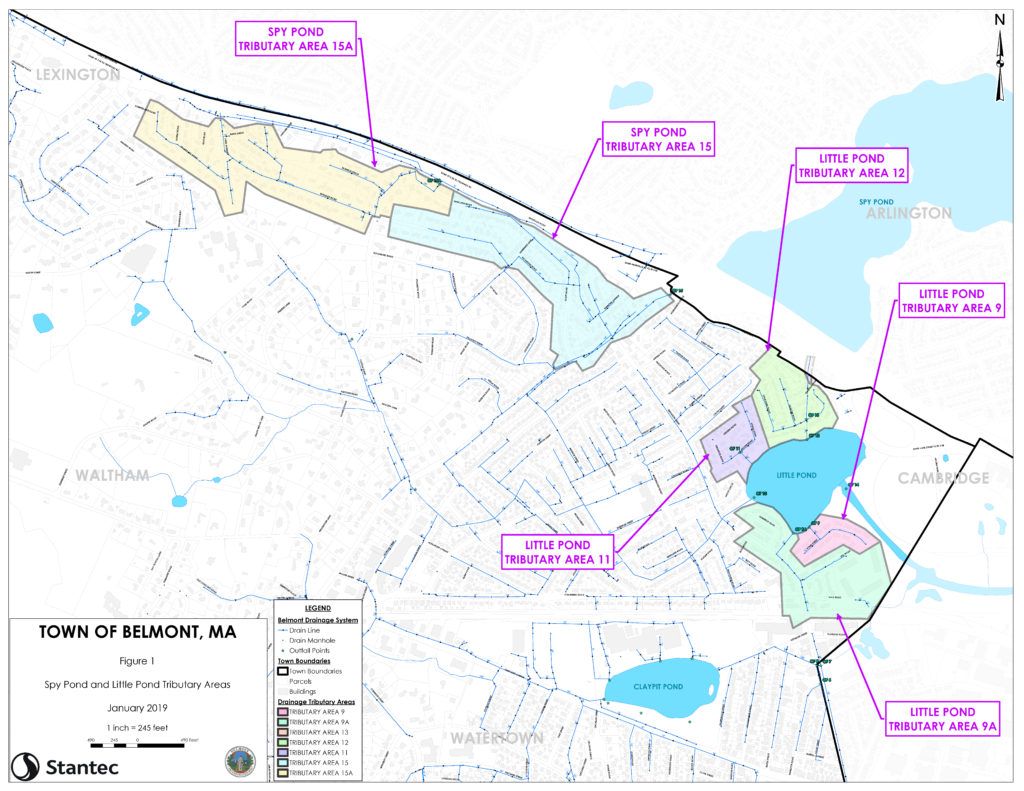By Anne-Marie Lambert
Belmont is working under a federal consent order to reduce the pollution it sends into Boston Harbor from leaks and connections of underground sewer pipes into the storm drain system.
Cleanup
According to the town’s January 30 Compliance Report to the US Environmental Protection Agency (EPA), Belmont redirected an additional 126 gallons per day (GPD) of sewage from our brooks and ponds to the Deer Island treatment plant in Boston Harbor. Sources included leaking sewer service laterals and sewer segments on Brettwood Road and Pierce Road (84 GPD) and three leaking sewer service laterals along Hoitt Road (42 GPD).
Opportunities
As a result of previous and ongoing investigations, including new testing in the Spy Pond/Little Pond tributaries of the drainage system, the next planned repairs will address illicit connections to the storm drain on Bow Road and Brighton Street, leaking sewer service laterals on Randolph Street, a sewer main along Oliver Road “in fair to poor condition with moderate to severe cracking, sags and offset joints,” and 20 service laterals along Oliver Road, also “in fair to poor condition with defects including offset/separated joints, cracks, root intrusion, and sags.”
Mystery Pipe Solved
In our last report (“Sewer Repairs In Progress to Clean Up Wellington Brook and Winn’s Brook”, September/October 2018 BCF Newsletter), the town had discovered mystery pipes connected to stormwater drains, coming from an unidentified source. Director of Community Development Glenn Clancy now believes they are likely coming from 1911-era underdrains. These were installed to facilitate the initial construction of sewer mains by draining ground water, but were then left in place underground. If this theory is confirmed, his team plans to plug and cap these drains. (See chart showing history of sewer and storm drain construction in “Finding Sewer Leaks Means Detective Work,” in the March/April 2018 BCF Newsletter.)

This map of the Spy Pond and Little Pond Tributary Areas shows the portions of Belmont’s stormwater system that drain into those two ponds at outfalls 9, 9A, 11, 12, 15, and 15A. The largest tributary area, draining into Little Pond at outfall 10, is the Winn’s Brook Tributary Area. This large tributary area, however, is not labeled explicitly on this map, which focuses on the smaller areas recently investigated. (Map courtesy of Stantec Consulting Services Inc.)
Testing, Testing, Testing
The amount of testing required to find a handful of pollution sources continues to be impressive. The bulk of the Report on Compliance describes meticulous and systematic testing from the periphery of each tributary in the drainage system to each outfall. This includes sampling and testing for E.coli at certified labs, dye testing mains and laterals to individual homes, and sending CCTV cameras down drains.
On Track for May 2022
Clancy believes the town is on track to meet the five-year cleanup goal in the town’s consent order with the EPA. “We are peeling back the onion and still finding problems—the repair of one direct connection could be the source we have been looking for.” The EPA date is posted prominently by Clancy’s desk.
Anne-Marie Lambert is co-director of the Belmont Stormwater Working Group and a former director of the Belmont Citizens Forum.


Sorry, the comment form is closed at this time.